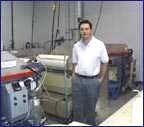
Curated with aloha by
Ted Mooney, P.E. RET

The authoritative public forum
for Metal Finishing 1989-2025

-----
Quantitative Determination of Surface Iron Oxide
Q. I am looking for a method to, quantitatively determine the amount of corrosion that is on the surface of a cold rolled steel plate. We have tried ESCA/Auger analysis and the results are not quantitative, relating only to thickness. I would appreciate any suggestions.
Thanks
Tim Shelley- Galesburg, Illinois
2001
A. ESCA and Auger can provide you quantitative measurement of the thickness and composition of thin surface layers on steel. What exactly are you trying to quantify and what are the expected values for these quantities?

Larry Hanke
Minneapolis, Minnesota
2001
A. In corrosion testing, most quantifications of red rust (iron oxide) are either at the first sign, or at a certain percentage of surface area, usually 5% or 10%. This type of measure is very qualitative, not quantitative. In corrosion testing, the laboratory technician often has to rely on personal judgement. It may not be what you're looking for, but that is standard industry practice in testing.

Tim Neveau
Rochester Hills, Michigan
2001
Q. Is there any way to calculate the thickness of oxide layer on steel sample if we know the amount of weight dissolved during the chemical process of dissolution of oxide layer?
Ex.: initial sample steel+oxide layer on it,
final sample only steel sample;
so how to calculate that thickness of oxide layer previously formed?
- warangal, A.P. India
May 23, 2013
A. Hi Manthan. Although iron III oxide (red rust) has a density of 5.242 g/cm3, so you could calculate the volume of rust from its weight, and divide by the surface area to get the thickness, here's the thing:
You probably could sell potatoes or bread by the liter, but liters are just not a particularly useful measurement unit for those items. Similarly, "thickness of iron oxide layer on steel" tends to not be a particularly useful and informative unit of measure because the iron oxide could be crusty mill scale, converted black rust, or fluffy and non-adherent red rust. And why assume the oxide was of uniform consistent thickness rather than thick in one spot and thin or non-existent in another. And if the surface is pock-marked with pits full of rust, how would you factor that in?
Thus, I think you did the right thing by weighing the iron oxide, and I feel you should probably express the amount of iron oxide in grams, or in grams per square decimeter of surface, or in grams per kilogram of metal rather than trying to express it in terms of thickness. Best of luck.
Regards,

Ted Mooney, P.E.
Striving to live Aloha
finishing.com - Pine Beach, New Jersey
May 24, 2013
Q, A, or Comment on THIS thread -or- Start a NEW Thread